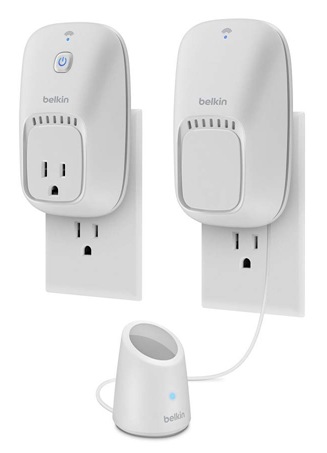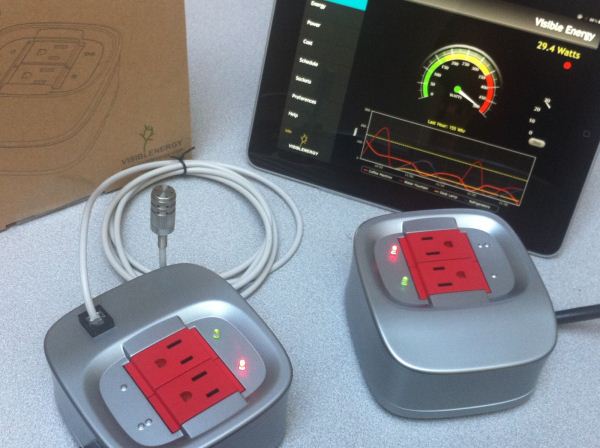Home Automation and the 'Internet of Things'
by Ganesh T S on October 4, 2012 10:30 AM EST- Posted in
- Gadgets
- Home Automation
- Wi-Fi
Power switching is a simple home automation application in which a device can be powered up or down at the socket level remotely. Simple Wi-Fi switches such as the NetRC1 have been around since early 2010. One of the first mainstream companies to enter into this space was Belkin. In this section, we will take a look at two interesting Wi-Fi based power switches, the Belkin WeMo kits and Visible Energy’s offerings.
Belkin WeMo
Belkin’s WeMo lineup consists of two offerings, the plain WeMo Wi-Fi controlled switch ($50) and the WeMo switch combined with a motion sensor ($100). Currently, only an iOS app is available for controlling the switch.

A web-service called ‘If This Then That’ works with these switches and allows bidirectional reaction to events. For example, a event triggering the motion sensor on a particular unit could be used to generate an email message. Similarly, an event happening on a website (say, a weather channel website indicating that the sun has set at a particular location) can trigger a particular switch on.
Currently, the device seems to be recommendable only to consumers in the Apple ecosystem because of the absence of an Android app. It is not clear whether the unit is accessible from a browser on the local network in the case that there is no access to the Internet and an iOS device is not available. Similar to the walled garden being created by Nest, Belkin also refuses to document the APIs officially. However, this has not prevented the communication methods from getting exposed. The concerns that I voiced in the earlier section regarding Nest warrant a repetition here too. Belkin does plan to add more Wi-Fi enabled home automation devices such as door locks and light bulbs to this lineup. That is a positive compared to having a dedicated app with a different UI for the thermostat alone. In any case, home automation system adopters should try to ensure that the components being put in have well-documented control interfaces.
Visible Energy
My search for an economical and open Wi-Fi power switch ended when I spotted Visible Energy’s UFO Power Center and Monostrip. In addition to the ability to power the outlets up and down over Wi-Fi, they also provide real time power usage feedback. Like the WeMo, only an iOS app is available right now. However, web access is also provided using the Visible Energy Web Dashboard. The four-outlet UFO Power Center comes in at $130, while the two-socket Monostrip comes in at $49. Visible Energy also sells a version of the Monostrip with temperature and humidity sensors at $130.
The UFO power center has a strange industrial design, while the Monostrip is a little more conventional in nature. While we are looking at the two units from a Home Automation perspective, the company stresses the fact that the products are more about conserving electricity and creating a user friendly energy management system.
The energy management goals make it necessary for the product to have real time power monitoring. This is a very useful feature (actually, the primary feature) present in Visible Energy’s products when compared to other Wi-Fi enabled power switches. Power consumption is calculated and refreshed every second. Energy usage is calculated 50 times a second and the data is recorded at 5 minute intervals.
The real clincher is the availability of extensive developer documentation for accessing the energy / power data and controlling the units. This makes it easy for third parties to create custom interfaces in a home automation setting.












54 Comments
View All Comments
at80eighty - Thursday, October 4, 2012 - link
I have been poking around very recently to check out articles about this very topic, and wouldn't you know, you guys do something about it. thanks for the read.is this something you could be exploring as a series of articles? maybe something every few months; would love to know more in depth info esp. DIY stuff.
slickr - Saturday, October 6, 2012 - link
How is this awesome? Its 1984 on steroids. If you don't think government isn't going to use this to spy on your 24/7 and turn you into a mindless slave then you don't know history.Basically what you eat, what you drink, which appliances you use, how you dress, who you with, etc... will all be public for governments or hackers to get a hold of.
I think this is ridiculous, its bad, its negative, its Orwellian, its NAZI Germany like, its Brave new world like.
Axedall - Sunday, October 7, 2012 - link
How exactly do you think a government would use information like this? What are you eating that would anyone would be interested in? Babies? Are you dressing yourself in radioactive waste?And what makes you think that this information isn't available to pretty much anyone who wants it anyway? Do you use a credit card? Do you have a bank account (other than off shore)? A membership card for any kind of store? Unless you are using cash for every transaction you make, they are all being recorded and tracked. Not likely by the government, but certainly by corporations who will use it to tailor marketing strategies.
I'm surprised you are even using the internet. You realize that every website you visit can be tracked as well as your location don't you? Quick, better crawl back under a rock before 'they' find you!
As an aside... great article and thanks for providing information on emerging technology like this. Maybe some coverage on security issues would be a good idea, however, as this seems to be a pretty big concern for a number people. Admittedly, if I can control electrical appliances in my house remotely from a smart phone, someone else potentially could too.
rangerdavid - Sunday, October 28, 2012 - link
The only way you can prevent this from happening is by using this tinfoil. Wrap it around your head.Yes, just like that, but you missed the area covering your mouth.
There, better. :)
Violated - Tuesday, September 3, 2013 - link
Wow, I wish I would have read this last year! Slickr hit the nail on the head. I had Night Owl surveillance cameras outside my home and all new appliances and a new furnace, as well as a fully formally monitered security system. My ex while living here allowed access and set up basically a home I had no privacy, control or in reality ownership of. To make matters worse she was an especially vindictive woman and made me listen to unpeakable things via a RPC 2700/Ubuntu network she had secretly set up!!!I'm just finally figuring it all out, thankfully I'm still alie and can prove all the crazy things she's done.
DaveLessnau - Thursday, October 4, 2012 - link
And I'll bet that all these Home Automation vendors will put just a bunch of effort into hardening their products so that the fine people of our society won't hack our houses and turn our lives into living nightmares.Right.
Heck, they don't even harden medical devices. For that matter, they don't harden cell phones (which have turned into the core of people's lives).
DanNeely - Thursday, October 4, 2012 - link
If wifi wins the standard war anyone who has half a clue should be able to use WPA and a strong password to secure their HA systems. Granted the half clue needed to do so is a relatively high bar; but the clueless will break any other protection system too.k2_8191 - Thursday, October 4, 2012 - link
Agreed.I will never buy such network-enabled appliances.
I don't want to see my house flooded by hot water of a badly-designed spa :(
ntspam - Friday, October 5, 2012 - link
You can buy flood and freeze sensors that alert your phone. By the way you can pick and choose what you automate.aruisdante - Thursday, October 4, 2012 - link
Even if vendors do nothing, it's as secure as any home WiFi network is. All you have to do is enable WPA2 and its unlikely that anyone that would care is going to be able to get into your network.